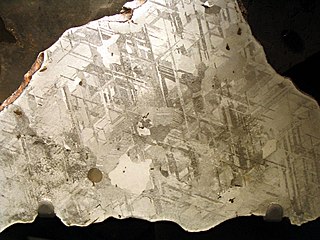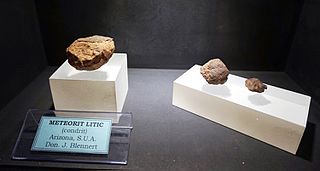Related Research Articles

Kamacite is an alloy of iron and nickel, which is found on Earth only in meteorites. The proportion iron:nickel is between 90:10 and 95:5; small quantities of other elements, such as cobalt or carbon may also be present. The mineral has a metallic luster, is gray and has no clear cleavage although its crystal structure is isometric-hexoctahedral. Its density is about 8 g/cm3 and its hardness is 4 on the Mohs scale. It is also sometimes called balkeneisen.

A meteorite classification system attempts to group similar meteorites and allows scientists to communicate with a standardized terminology when discussing them. Meteorites are classified according to a variety of characteristics, especially mineralogical, petrological, chemical, and isotopic properties.

Schreibersite is generally a rare iron nickel phosphide mineral, (Fe,Ni)
3P, though common in iron-nickel meteorites. The only known occurrence of the mineral on Earth is located on Disko Island in Greenland.

Hexahedrites are a structural class of iron meteorite. They are composed almost exclusively of the nickel–iron alloy kamacite and are lower in nickel content than the octahedrites. The nickel concentration in hexahedrites is always below 5.8% and only rarely below 5.3%.

The pallasites are a class of stony–iron meteorite.

Iron meteorites, also known as siderites, or ferrous meteorites, are a type of meteorites that consist overwhelmingly of an iron–nickel alloy known as meteoric iron that usually consists of two mineral phases: kamacite and taenite. Iron meteorites originate from cores of planetesimals.

IAB meteorites are a group of iron meteorites according to their overall composition and a group of primitive achondrites because of silicate inclusions that show a strong affinity to winonaites and chondrites.

IIICD meteorites are a group of primitive achondrites. They are classified in a clan together with the IAB meteorites and the winonaites.

Daubréelite is a rare sulfide mineral. It crystallizes with cubic symmetry and has chemical composition of Fe2+Cr3+2S4. It usually occurs as black platy aggregates.

Brachinites are a group of meteorites that are classified either as primitive achondrites or as asteroidal achondrites. Like all primitive achondrites, they have similarities with chondrites and achondrites. Brachinites contain 74 to 98% (Volume) olivine.

The Zakłodzie meteorite is a stony-iron meteorite found in Poland in 1998. Its mass is 8.68 kilograms (19.1 lb). It is composed predominantly from enstatite and meteoric iron. Currently classified as an ungrouped enstatite achondrite its classification is still an ongoing scientific debate.

The Eagle Station group is a set of pallasite meteorite specimen that don't fit into any of the other defined pallasite groups. In meteorite classification five meteorites have to be found, so they can be defined as their own group. Currently only five Eagle Station type meteorites have been found, which is just enough for a separate group.
The Santa Vitoria do Palmar meteorite was found near the city of Santa Vitoria do Palmar in Brazil in 2003 and 2004.
IIG meteorites are a group of iron meteorites. The group currently has six members. They are hexahedrites with large amounts of schreibersite. The meteoric iron is composed of kamacite.
The Twannberg meteorite is a hexahedrite iron meteorite. It is the only meteorite of the IIG group found in Europe and the largest meteorite ever found in Switzerland.
The Vermillion meteorite is a pallasite (stony-iron) meteorite and one of two members of the pyroxene pallasite grouplet.
This is a glossary of terms used in meteoritics, the science of meteorites.

The Mundrabilla meteorite is an iron meteorite found in 1911 in Australia, one of the largest meteorites found, with a total known weight of 22 tonnes and the main mass accounting for 12.4 tonnes.

IIAB meteorites are a group of iron meteorites. Their structural classification ranges from hexahedrites to octahedrites. IIABs have the lowest concentration of nickel of all iron meteorite groups. All iron meteorites are derived from the metallic planetary cores of their respective parent bodies, but in the case of the IIABs the metallic magma separated to form not only this meteorite group but also the IIG group.
The Lake Murray Meteorite, the largest of its kind ever found in Oklahoma and now ranked as the fifth largest in the world, was discovered on a farm in Carter County, Oklahoma in 1933. At that time it was considered the largest known specimen in the world. The farm was sold to the state of Oklahoma about the same time for the creation of Lake Murray State Park, for which the specimen was named. The largest piece is on display at the park.
References
- 1 2 3 4 5 "Bellsbank". Meteoritical Society. Retrieved 28 December 2012.
- 1 2 3 4 Wasson, John T.; Choe, Won-Hie (31 July 2009). "The IIG iron meteorites: Probable formation in the IIAB core". Geochimica et Cosmochimica Acta. 73 (16): 4879–4890. Bibcode:2009GeCoA..73.4879W. doi:10.1016/j.gca.2009.05.062.
- 1 2 Groeneveld, D. (1959). "A new iron meteorite from Bellsbank, Barkly West district". Transactions of the Geological Society of South Africa. 62: 72–80. Archived from the original on 2013-07-29. Retrieved 2012-12-28.